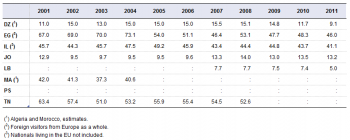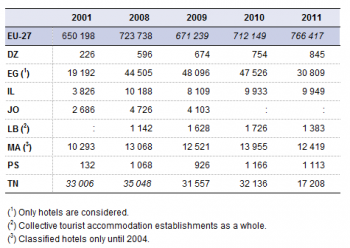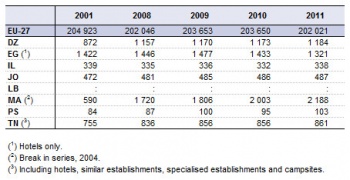Archive:Tourism statistics - North Africa and Eastern Mediterranean
Effects of political instability clearly felt
Statistics in focus 3/2014; Author: Rosemary MONTGOMERY
ISSN:2314-9647 Catalogue number:KS-SF-14-003-EN-N
This Statistics Explained article is outdated and has been archived - for recent articles on tourism statistics see here.
This article presents recent statistics on the tourism industry in the Mediterranean partner countries of the European Union (EU): eight Mediterranean countries covered by the European Neighbourhood Policy (ENP-South countries). It offers an overview of tourism intensity and developments between 2001 and 2011.
Situated on the southern and eastern coasts of the Mediterranean and endowed with a rich history and culture, the ENP-South countries [1] are popular tourist destinations, especially for Europeans, Americans and tourists from other Arab countries. The global economic downturn in 2008 affected tourism slightly in most of these countries, but the effects of the Arab Spring in 2011 are much more obvious.













Main statistical findings
Tourist arrivals
Between 2001 and 2010, there was a significant increase in the number of tourists entering all of the ENP-South countries for which data are available. Egypt in particular saw a threefold increase in the number of tourists between 2001 and 2010, when 14.7 million tourists were recorded, making Egypt by far the most important ENP-South country in terms of tourist arrivals.
Following the events of the Arab Spring, this spectacular growth was reversed: the number of tourists arriving in Egypt fell by a third in 2011, though this is still twice as many as in 2001. A similar trend was also reported in Tunisia, where the number of tourists steadily grew between 2001 and 2008, halted between 2008 and 2010 before experiencing a drop of over 30 % in 2011, also due to political and social uncertainties. Although the political situation in Jordan remained stable in 2011, tourism there was also affected by the general tension in the region, falling by 17 % between 2010 and 2011.
Tourists to Egypt, Tunisia, Morocco and Israel have been predominately from Europe, though their share has fallen since 2001. In Egypt, the proportion of tourists from Europe peaked in 2004 when 73.1 % of all tourists were from the EU-27 Member States. By 2011, their share had dropped by 27 percentage points, to 46 %.
As tourism is very sensitive to social unrest and political instability, it is not surprising that the share of EU-27 tourists has further dropped in 2011 (as far as data are available).
Nights spent in hotels and similar establishments
In parallel with the general rise in the number of visitors, there was also an increase in the number of nights spent in hotels and similar establishments in the ENP-South countries between 2001 and 2011. The number of nights spent by non-residents largely outnumbers that of residents in absolute terms (with the exception of Algeria and Israel). The increase was higher for non-residents than for residents, but in 2011, for reasons mentioned earlier, the number of nights spent by non-residents plummeted in most ENP-South countries, and most notably in Egypt and Tunisia. Tourism in Algeria is less well developed than in its neighbours Morocco, Tunisia and Egypt, and a lot of tourist arrivals in Algeria have family connections in the country and will stay with family rather than in hotels. Nights spent in hotels by residents were far less affected by political and social uncertainties in recent years and were stable between 2010 and 2011. Algeria, Morocco and Palestine even reported noticeable increases.
One indicator of the importance of tourism in the economy of a country is the tourism intensity ratio. Expressed as the number of nights spent by tourists relative to the population of the host country, the ratio in many ENP-South countries appears surprisingly low, especially compared with that of the EU. It was highest in Israel and Tunisia (2011, estimate), with ratios equivalent to almost three and two nights respectively for every inhabitant on average. In all other countries, the ratio was well under one night per inhabitant. These low ratios should be considered against a large population (explaining the low values) but also against the regional distribution. Tourism in the ENP-South countries is indeed often concentrated in only a few areas (most often on the coasts); national values then insufficiently reflect the regional economic impact and importance of tourism.
Accommodation establishments and bed capacity
In Israel, the number of hotels and similar establishments has remained quite stable throughout the decade, while in Jordan, Tunisia and Palestine (in 2009) there were 2.8 %, 14.0 % and 22.6 % more hotels respectively compared with 2001.
In Egypt, the number of hotels and similar establishments grew until 2009, and then fell by 10.6 % between 2009 and 2011. This decline occurred essentially between 2010 and 2011 and may be explained by the period of unrest that climaxed in January/February 2011. The closure of hotels might be of a temporary nature; many hotel management companies and hotel owners have decided to lay-off all non-essential personnel in order to minimise losses. Hotels can then be re-opened when demand rises.
Together, hotels and similar establishments provided almost a million (989 000) bed places in the ENP-South countries in 2011 (for which data are available), of which more than two-thirds (67 %) were concentrated in three countries: Egypt (254 000 bed places), Tunisia (242 000 bed places) and Morocco (184 000 bed places).
Unsurprisingly, the lowest number of bed places in hotels and similar establishments in the entire ENP-South region in absolute terms was reported in Palestine, with 12 000 bed places available in 2011, nonetheless a considerable increase compared with the 7 000 bed places reported in 2001.
Large sea-side holiday resort hotels tend to dominate the hotel structure, particularly in the Maghreb countries. In 2011, the average hotel capacity in ENP–South countries was considerably higher than in the EU-27 (where it amounted to 62.4 beds in 2011). Israel reported the highest average number of bed places per hotel in 2011 (328.4 beds); this figure being however lower than in 2001 (336.3 beds).
In the same period, a trend towards larger hotels was observed in Palestine (113.6 beds), Egypt (198 beds in 2010), Jordan (90.7 beds in 2009) and Tunisia (281 beds), where figures were 36.4 %, 21.0 %, 15.7 % and 3.0 % respectively higher than in 2001.
Residents travelling abroad
Between 2001 and 2011, the number of ENP-South countries’ residents travelling abroad showed a very gradual increase in Algeria and Israel. In Egypt, the fluctuations were rather high, with a sharp fall in 2008, coinciding with the global economic downturn, and another clear drop between 2010 and 2011 for reasons mentioned earlier. Relatively few residents left Lebanon in 2006, the year of the so-called July war, a 34-day military conflict in Lebanon, northern Israel and the Golan Heights. And political tensions in the region also led to more residents staying at home in 2011.
The number of Israeli residents travelling abroad in 2011 was over 4 million, an increase of 23.2 % since 2001. The almost 2 million Algerian residents who travelled abroad in 2011 corresponded to an increase of 44.2 %, compared with 2001.
Data sources and availability
The data for the ENP are supplied by and under the responsibility of the national statistical authorities (NSIs) of each of the countries or territories on a voluntary basis. Data from other sources are very limited and clearly identified. The data for Algeria, Egypt, Israel, Jordan, Lebanon, Morocco, Palestine territory, Syria and Tunisia are collected by Eurostat directly from the relevant NSIs. The statistics that are included in this article are freely available on-line and form part of the Pocketbook on Euro-Mediterranean statistics - 2013 edition
Context
Tourism statistics traditionally focus on the accommodation sector on the one hand and the demand side on the other hand. The available tourism statistics relate mainly to physical flows: arrivals or nights spent at tourist accommodation establishments or trips made by residents of a country.
Situated on the southern and eastern coasts of the Mediterranean and endowed with a rich history and culture, the ENP-South countries [2] are popular tourist destinations, especially for Europeans, Americans and tourists from other Arab countries. The global economic downturn in 2008 affected tourism slightly in most of these countries, but the effects of the Arab Spring in 2011 are much more obvious. The policy context of the European Neighbourhood Policy (ENP) is explained in International statistical cooperation.
See also
Further Eurostat information
Publications
- European Neighbourhood Policy Countries Leaflets - 2014
- Pocketbook on the Euro-Mediterranean statistics – 2013
- Pocketbook on the Euro-Mediterranean statistics – 2012
- Pocketbook on the Euro-Mediterranean statistics – 2011
Database
- Population and social conditions (med_ps)
Dedicated section
Methodology / Metadata
- Southern European Neighbourhood Policy countries (ENP-South) (ESMS metadata file — med_esms)
External links
- European External Action Service – Euro-Mediterranean Partnership (EUROMED)
- European External Action Service - European Neighbourhood Policy
Notes